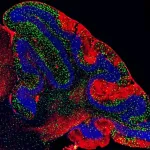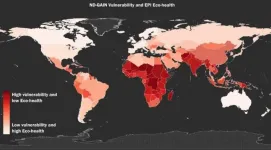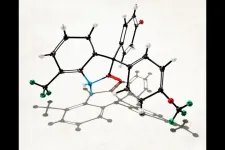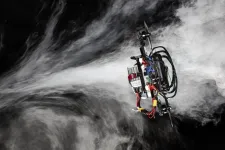(Press-News.org) BROOKLYN, New York, Weekday, Month xx, 2021 - The remarkable structural properties of the Venus' flower basket sponge (E. aspergillum) might seem fathoms removed from human-engineered structures. However, insights into how the organism's latticework of holes and ridges influences the hydrodynamics of seawater in its vicinity could lead to advanced designs for buildings, bridges, marine vehicles and aircraft, and anything that must respond safely to forces imposed by the flow of air or water.
While past research has investigated the structure of the sponge, there have been few studies of the hydrodynamic fields surrounding and penetrating the organism, and whether, besides improving its mechanical properties, the skeletal motifs of E. Aspergillum underlie the optimization of the flow physics within and beyond its body cavity.
A collaboration across three continents at the frontiers of physics, biology, and engineering co-led by END
How a unique sponge 'goes with the flow' could improve man-made structures
Collaborative project taps one of the world's most powerful supercomputers to reveal the water-bending skills of the Venus basket sponge. Insights could have implications for man-made craft and structures
2021-07-21
ELSE PRESS RELEASES FROM THIS DATE:
Team streamlines neural networks to be more adept at computing on encrypted data
2021-07-21
BROOKLYN, New York, Wednesday, July 21, 2021 - This week, at the 38th International Conference on Machine Learning (ICML 21), researchers at the END ...
Dynamic heart model mimics hemodynamic loads, advances engineered heart tissue technology
2021-07-21
Efforts to understand cardiac disease progression and develop therapeutic tissues that can repair the human heart are just a few areas of focus for the Feinberg research group at Carnegie Mellon University. The group's latest dynamic model, created in partnership with collaborators in the Netherlands, mimics physiologic loads on engineering heart muscle tissues, yielding an unprecedented view of how genetics and mechanical forces contribute to heart muscle function.
"Our lab has been working for a long time on engineering and building human heart muscle tissue, so we can better ...
Researchers find immune component to rare neurodegenerative disease
2021-07-21
UT Southwestern researchers have identified an immune protein tied to the rare neurodegenerative condition known as Niemann-Pick disease type C. The END ...
New study confirms relationship between toxic pollution, climate risks to human health
2021-07-21
For more than 30 years, scientists on the U.N.'s Intergovernmental Panel on Climate Change have focused on human-induced climate change. Their fifth assessment report led to the Paris Agreement in 2015 and, shortly after, a special report on the danger of global warming exceeding 1.5 degrees Celsius above pre-industrial levels. The Nobel Prize-winning team stressed that mitigating global warming "would make it markedly easier to achieve many aspects of sustainable development, with greater potential to eradicate poverty and reduce inequalities."
In a first-of-its-kind study that combines assessments of the risks of toxic emissions (e.g., fine particulate matter), ...
Exoskeletons have a problem: They can strain the brain
2021-07-21
COLUMBUS, Ohio - Exoskeletons - wearable devices used by workers on assembly lines or in warehouses to alleviate stress on their lower backs - may compete with valuable resources in the brain while people work, canceling out the physical benefits of wearing them, a new study suggests.
The study, published recently in the journal Applied Ergonomics, found that when people wore exoskeletons while performing tasks that required them to think about their actions, their brains worked overtime and their bodies competed with the exoskeletons rather than working in harmony with them. The study indicates that exoskeletons may place enough burden on the brain that potential benefits to the body are negated.
"It's almost like dancing with a really bad partner," said ...
New approach eradicates breast cancer in mice
2021-07-21
CHAMPAIGN, Ill. -- A new approach to treating breast cancer kills 95-100% of cancer cells in mouse models of human estrogen-receptor-positive breast cancers and their metastases in bone, brain, liver and lungs. The newly developed drug, called ErSO, quickly shrinks even large tumors to undetectable levels.
Led by scientists at the University of Illinois Urbana-Champaign, the research team reports the findings in the journal Science Translational Medicine.
"Even when a few breast cancer cells do survive, enabling tumors to regrow over several months, the tumors that regrow remain completely ...
Study finds calcium precisely directs blood flow in the brain
2021-07-21
Unlike the rest of the body, there is not enough real estate in the brain for stored energy. Instead, the brain relies on the hundreds of miles of blood vessels within it to supply fresh energy via the blood. Yet, how the brain expresses a need for more energy during increased activity and then directs its blood supply to specific hot spots was, until now, poorly understood.
Now, University of Maryland School of Medicine and University of Vermont researchers have shown how the brain communicates to blood vessels when in need of energy, and how these blood vessels respond by relaxing or constricting to direct blood flow to specific brain regions.
In their new paper, published on July 21 in Science Advances, ...
Powerline failures and wind speeds are strongest drivers of land area burned by Santa Ana wind fires
2021-07-21
Every year, Santa Ana Winds drive some of the largest wildfires in Southern California during autumn and winter, and a new analysis of 71 years of data suggests that the total amount of land burned is determined more by wind speed and power line ignitions than by temperature and precipitation. The findings suggest that maintaining utility lines and carefully planning urban growth to reduce powerline ignitions may help to reduce future losses from Santa Ana-driven autumn and winter fires, which occur far less frequently than summer fires but account for the largest blazes annually. While California's summer fires are typically driven by an abundance of fuels such as dry twigs and logs, and are often ignited by lightning in remote areas, the state's autumn and winter fires are typically ...
New algorithm flies drones faster than human racing pilots
2021-07-21
To be useful, drones need to be quick. Because of their limited battery life they must complete whatever task they have - searching for survivors on a disaster site, inspecting a building, delivering cargo - in the shortest possible time. And they may have to do it by going through a series of waypoints like windows, rooms, or specific locations to inspect, adopting the best trajectory and the right acceleration or deceleration at each segment.
Algorithm outperforms professional pilots
The best human drone pilots are very good at doing this and have so far always outperformed autonomous systems in drone racing. Now, a research group at the University of Zurich (UZH) has created an algorithm that can find the quickest ...
Study finds lifting advice doesn't stand up for everyone
2021-07-21
Commonly accepted advice to keep a straight back and squat while lifting in order to avoid back pain has been challenged by new Curtin University research.
The research examined people who had regularly performed manual lifting through their occupation for more than five years and found those who experienced low back pain as a result were more likely to use the recommended technique of squatting and keeping a straight back, while those without back pain tended not to adhere to the recommended lifting advice.
Lead researcher PhD candidate Nic Saraceni from the Curtin School of Allied Health said the study required participants to each perform 100 lifts using two differently weighted boxes, with researchers ...
LAST 30 PRESS RELEASES:
Ribosomal engineering creates “super-probiotic” bacteria
This self-powered eye tracker harnesses energy from blinking and is as comfortable as everyday glasses
Adverse prenatal exposures linked to higher rates of mental health issues, brain changes in adolescents
Restoring mitochondria shows promise for treating chronic nerve pain
Nature study identifies a molecular switch that controls transitions between single-celled and multicellular forms
USU chemists' CRISPR discovery could lead to single diagnostic test for COVID, flu, RSV
Early hominins from Morocco reveal an African lineage near the root of Homo sapiens
Small chimps, big risks: What chimps show us about our own behavior
We finally know how the most common types of planets are created
Thirty-year risk of cardiovascular disease among healthy women according to clinical thresholds of lipoprotein(a)
Yoga for opioid withdrawal and autonomic regulation
Gene therapy ‘switch’ may offer non-addictive pain relief
Study shows your genes determine how fast your DNA mutates with age
Common brain parasite can infect your immune cells. Here's why that's probably OK
International experts connect infections and aging through cellular senescence
An AI–DFT integrated framework accelerates materials discovery and design
Twist to reshape, shift to transform: Bilayer structure enables multifunctional imaging
CUNY Graduate Center and its academic partners awarded more than $1M by Google.org to advance statewide AI education through the Empire AI consortium
Mount Sinai Health system receives $8.5 million NIH grant renewal to advance research on long-term outcomes in children with congenital heart disease
Researchers develop treatment for advanced prostate cancer that could eliminate severe side effects
Keck Medicine of USC names Christian Pass chief financial officer
Inflatable fabric robotic arm picks apples
MD Anderson and SOPHiA GENETICS announce strategic collaboration to accelerate AI-driven precision oncology
Oil residues can travel over 5,000 miles on ocean debris, study finds
Korea University researchers discover that cholesterol-lowering drug can overcome chemotherapy resistance in triple-negative breast cancer
Ushikuvirus: A newly discovered giant virus may offer clues to the origin of life
Boosting the cell’s own cleanup
Movement matters: Light activity led to better survival in diabetes, heart, kidney disease
Method developed to identify best treatment combinations for glioblastoma based on unique cellular targets
Self-guided behavioral app helps children with epilepsy sleep earlier
[Press-News.org] How a unique sponge 'goes with the flow' could improve man-made structuresCollaborative project taps one of the world's most powerful supercomputers to reveal the water-bending skills of the Venus basket sponge. Insights could have implications for man-made craft and structures



